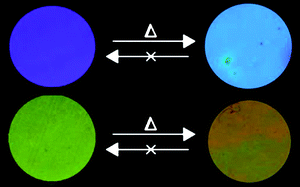Time–temperature indicators for high temperature applications†
Abstract
New thermochromic materials are reported, which are useful for application as time–temperature

* Corresponding authors
a
Department of Macromolecular Science and Engineering, Case Western Reserve University, 2100 Adelbert Road, Cleveland, Ohio, USA
E-mail:
christoph.weder@case.edu
Fax: (+1)216-368-420
New thermochromic materials are reported, which are useful for application as time–temperature

 Please wait while we load your content...
Something went wrong. Try again?
Please wait while we load your content...
Something went wrong. Try again?
C. E. Sing, J. Kunzelman and C. Weder, J. Mater. Chem., 2009, 19, 104 DOI: 10.1039/B813644K
To request permission to reproduce material from this article, please go to the Copyright Clearance Center request page.
If you are an author contributing to an RSC publication, you do not need to request permission provided correct acknowledgement is given.
If you are the author of this article, you do not need to request permission to reproduce figures and diagrams provided correct acknowledgement is given. If you want to reproduce the whole article in a third-party publication (excluding your thesis/dissertation for which permission is not required) please go to the Copyright Clearance Center request page.
Read more about how to correctly acknowledge RSC content.
 Fetching data from CrossRef.
Fetching data from CrossRef.
This may take some time to load.
Loading related content
